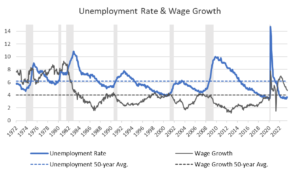Slow Growth Ahead
2Q 2023
The year 2023 has started much differently than 2022 as both the stock and bond markets have rebounded from the lows that we saw last October. Despite elevated inflation, rising interest rates, and continued geopolitical disruptions, the U.S. economy has remained resilient, and a recession does not appear imminent. Despite this positive beginning, we are still likely to see slower growth and potentially a recession within the next year as the Fed is expected to possibly raise interest rates two more times and credit conditions continue to tighten. The good news is that we should be finally nearing the end of the Fed tightening and eventually see easing, which would be welcome relief for businesses and consumers alike.
Inflation, the Fed’s sworn enemy, appears to have peaked at 8.9% year-over-year in June 2022 and has retreated to 3.1% as of the end of June 2023.[1] This has been driven primarily by declining energy and food prices over the past few months (I happily saw a dozen eggs for $1.30 the other day). Core CPI, which is what the Fed is focused on, excludes food and energy prices, has also declined, but remains elevated at 4.9%. However, shelter, the stickiest part of inflation and largest component of Core CPI, has also begun to moderate. Since shelter reflects market conditions with a lag, it should continue to decline in the coming months, driving overall inflation lower with it.
Equity markets appear strong when viewed as a whole, but the rally has been primarily driven by growth-oriented companies, particularly large cap growth companies. Seven large cap growth companies have contributed almost 75% of the total market return this year: Apple, Microsoft, Nvidia, Amazon, Meta, Alphabet, and Tesla[2]. While large cap growth, as measured by the Russell 1000 Growth Index, was up over 29% year-to-date through June, large cap value was up just a little over 5%.[3] This story was the reverse in 2022, with value handily outperforming growth, which highlights the need to stay diversified and rebalance when appropriate.
Corporate earnings remain robust and U.S. businesses appear to be on solid footing, however, with the potential for slowing growth, many companies have mentioned reducing capital expenditures and their demand for labor has been cooling. While the labor market remains strong relative to the last 50 years, unemployment claims have been trending higher, averaging 240 thousand in the second quarter compared to 214 thousand in 2022.[4] In June, the top-line unemployment rate fell one tenth of a percent to 3.6%, still well below the 6.2% 50-year average, but the U-6 unemployment rate, which includes “part-time for economic reasons” workers, rose two tenths to 6.9%, the highest since August 2022. Year-over-year wage growth has also been slowing for the last twelve months, although still above its 50-year average. So, while employment remains strong, it is clearly slowing.
Source: St. Louis Federal Reserve, Brand AMG. Grey areas represent recessions.
As we mentioned last quarter, bank lending standards began tightening in 2022 and accelerated in 2023 to levels last seen during COVID and the Great Financial Crisis. With credit more expensive due to higher rates and loans more difficult to get, we expect further headwinds for business investment and consumer consumption, which will likely weigh on growth in the coming quarters.
While we are likely to continue to see slower growth in the economy in the coming months, things are not dire and the potential recession everyone has been worrying about is still somewhere in the future and unlikely to happen this year. While equity markets may continue to be volatile, we expect fixed income and alternative investments to provide some ballast to portfolios. The decline in markets in 2022 and subsequent rise in 2023 reminds investors of the importance of staying invested and rebalancing when appropriate. As always, we remain dedicated to helping you stay disciplined and maintaining a long-term view despite the short-term ups and downs that are inevitable in investing.
[1] Source: U.S. Bureau of Labor Statistics
[2] Source: Morningstar as of 6/26/23.
[3] Source: Morningstar Direct as of 6/30/23. Investors cannot invest directly in an index.
[4] Source: Department of Labor

